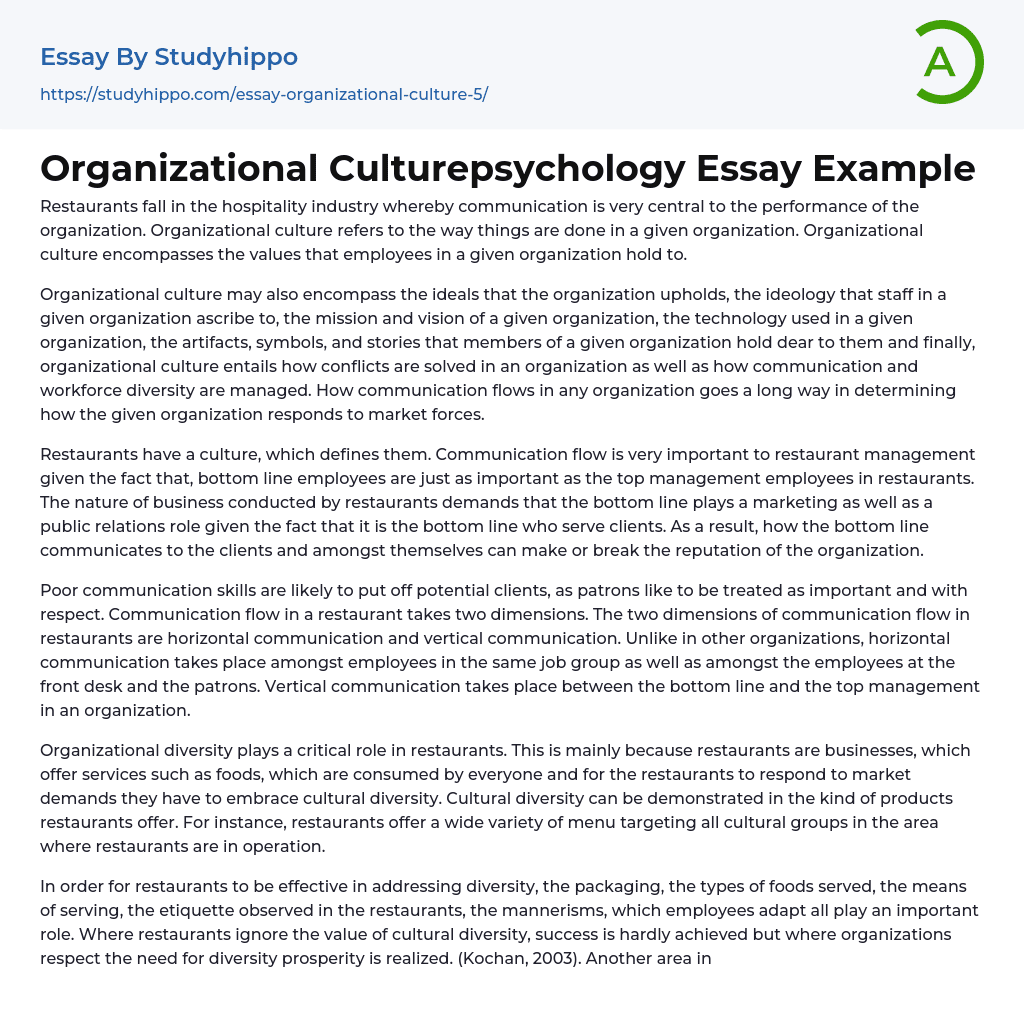The restaurant industry, a part of the larger hospitality sector, deeply values effective communication as it significantly impacts the functioning of the organization. Organizational culture, defined as the practices followed in an organization, largely comprises the principles upheld by its employees.
The elements of organizational culture can include the core beliefs, mission, and vision held by the organization, the values embraced by its workforce, the technology employed, and cherished symbols, artifacts, and narratives. It also involves the methods of conflict resolution and management of communication as well as workforce diversity. The way in which communication is facilitated within an organization significantly influences its response to market dynamics.
The culture within restaurants plays a defining role and the communication between employees of all levels is crucial, especially in restaurant management. The importance of bottom line employees equates to that of higher-level managemen
...t since they directly serve customers and uphold the marketing and public relations responsibilities. Therefore, their interaction with customers and each other can significantly impact the reputation of the restaurant.
A lack of effective communication skills can deter potential customers, because they desire to feel valued and respected. Communication in a restaurant operates in two directions. These include horizontal and vertical communication flows. In contrast to other businesses, horizontal communication happens between employees in the same role and also between front desk staff and customers. Vertical communication flows between lower-ranking employees and upper management within a company.
The significance of organizational diversity in the restaurant's operations and success is crucial. Being businesses providing universal services like food, restaurants need to cater to varying consumer demands, hence the necessity for cultural diversity. The representation of cultural diversity is evident i
the assortment of meals available in a restaurant's menu, aiming to satisfy the tastes of all cultural communities in their service areas.
Restaurants need to consider several things to be successful at addressing diversity. Considerations include the food packaging, the variety of food, the serving method, the decorum in the restaurants, and the behaviour of their workers. If a restaurant fails to value cultural diversity, it's less likely to succeed. But when they appreciate diversity, it often leads to growth and success (Kochan, 2003). The workforce is a key area where an organization's diversity can be seen in restaurants.
Workforce diversity pertains to the mixture of employees and overall personnel, originating from a broad range of cultural backgrounds. It's not merely about cultural diversity but it extends to differences in experience. For example, restaurants may hire chefs with varying degrees of expertise to form a competent and effective team. Furthermore, workforce diversity also aims to include individuals with different academic qualifications.
Various types of labor requirements are present in restaurants. For example, unskilled labor is crucial for performing manual tasks like laundering, dishwashing, and general upkeep. Unmistakably, such tasks wouldn't be suitable for semi-skilled workers who carry out specialized tasks like document processing and purchase handling. As for skilled labor, restaurants hire professional chefs proficient in cooking and managers with special expertise in restaurant operations.
The text evidently highlights the importance of diversity within a restaurant's organization. The importance of attire and communication in the restaurant business cannot be overstated. The hospitality service industry standard behaviors require a dress code, projecting an image of neatness and hygiene to patrons. Historically, restaurant staff have worn white attire, symbolic of maintaining
the utmost standards of hygiene within the restaurant.
The terminology employed in eateries is unique, as it utilizes specific jargon pertinent to the restaurant industry. This language is crucial for effective communication within these establishments. Thus, it can be confirmed that attire and language significantly contribute to the establishment of the organizational culture within restaurants (Schermerhorn, Hunt ; Osborn, 2005). To conclude, the discussion indicates that the perceptible elements defining an organization's culture are critical to its performance.
Despite the significance of communication transmission, varied structure, attire, language use, handling of disagreements, company guidelines, technology application, and the presence of artifacts, symbols, and stories in establishing corporate culture, it's the ways an organization coordinates communication, accommodates diversity and puts an emphasis on specific dress codes and language that truly matter in defining that organization's culture.
- Abnormal Psychology essays
- Social Psychology essays
- Developmental Psychology essays
- Jean Piaget essays
- Positive Psychology essays
- Classical Conditioning essays
- Counseling essays
- Psychoanalysis essays
- Educational Psychology essays
- Behaviorism essays
- Authority essays
- Operant Conditioning essays
- Maslow's Hierarchy Of Needs essays
- Mental Health essays
- Personality Psychology essays
- Psychotherapy essays
- Family Therapy essays
- Stanford Prison Experiment essays
- Abraham Maslow essays
- Erik Erikson essays
- Cognitive Psychology essays
- Sigmund Freud essays
- Attachment Theory essays
- Supersize Me essays
- Individual essays
- Infant essays
- Childhood essays
- Adolescence essays
- Growth Mindset essays
- Is Google Making Us Stupid essays
- Childhood Memory essays
- Positive Attitude essays
- Reinforcement essays
- Archetype essays
- Maturity essays
- Deception essays
- Certainty essays
- Conformity essays
- Aggression essays
- Behavior essays
- Human Behavior essays
- Obedience essays
- Adult essays
- Procrastination essays
- Morality essays
- Altruism essays
- Human Sexuality essays
- Role Model essays
- Perseverance essays
- Expressive essays




